DIY LED lamp: diagram, design nuances, self-assembly
LED lamps are widely used in household, street and industrial lighting.Their important advantages are efficiency, environmental friendliness, and low maintenance.
A DIY LED lamp will definitely find its application in your home. You will find detailed manufacturing instructions, as well as assembly diagrams, in the presented article.
The content of the article:
- Operating principle of LED device
- Four types of LED devices
- LED lamp device
- Advantages and disadvantages of a homemade lamp
- DIY problems
- LED lamp circuits
- Important element: LED driver
- Housings for LED devices
- Materials for making homemade products
- Assembling a simple LED lamp
- Conclusions and useful video on the topic
Operating principle of LED device
The basis of an LED lamp is a single-sided semiconductor, the size of which is several millimeters. There is a unidirectional movement of electrons in it, which allows you to convert alternating current into direct current.
An LED crystal consisting of several layers is characterized by two types of electrical conductivity: positively and negatively charged particles.
The side containing the minimum number of electrons is called hole (p-type), while the other with a large number of these particles is called electron (n-type).
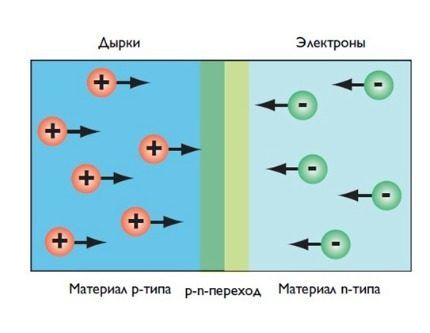
When elements at a pn junction collide, they collide, generating light particles called photons.If you keep the system at a constant voltage during this time, the LED will emit a stable stream of light. This effect is used in all LED lamp designs.
Four types of LED devices
Depending on the placement of LEDs, such models can be divided into the following categories:
- DIP. The crystal is arranged with two conductors, above which there is an enlarger. The modification has become widespread in the manufacture of signs and garlands.
- "Piranha". The devices are assembled similarly to the previous version, but have four outputs. Reliable and durable structures are most often used to equip cars.
- SMD. The crystal is placed on top, which significantly improves heat dissipation and also helps reduce the size of the devices.
- OWL. In this case, the LED is soldered directly into the board, which increases the glow intensity and protects against overheating.
A significant disadvantage of COB devices is the impossibility of replacing individual elements, which is why you have to purchase a new mechanism due to a single failed chip.
Chandeliers and other household lighting products typically use SMD design.
LED lamp device
The LED lamp consists of the following six parts:
- Light-emitting diode;
- base;
- driver;
- diffuser;
- radiator.
The operating element of such a device is an LED, which generates a stream of light waves.
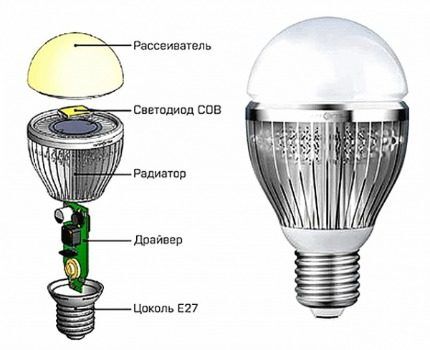
The base, which can have different shapes and sizes, is also used for other types of lamps - fluorescent, halogen, incandescent. At the same time, some LED devices, for example, LED strips, can do without this part.
An important design element is the driver, which converts the mains voltage into the current on which the crystal operates.
The efficient operation of the lamp largely depends on this unit; in addition, high-quality driver, having good galvanic isolation, provides a bright constant luminous flux without a hint of blinking.
A conventional LED produces a directional beam of light. To change the angle of its distribution and provide high-quality lighting, a diffuser is used. Another function of this component is to protect the circuit from mechanical and natural influences.
The radiator is designed to remove heat, excess of which can damage the device. Reliable operation of the radiator allows you to optimize the operation of the lamp and extend its life.
The smaller this part, the greater the thermal load the LED will have to withstand, which will affect the speed of its burnout.
Advantages and disadvantages of a homemade lamp
Specialized stores offer a large selection of LED devices. However, sometimes it is impossible to find a device in the assortment that meets the necessary parameters. In addition, LED devices are traditionally high in cost.
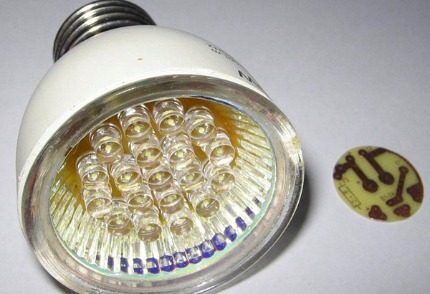
Meanwhile, it is quite possible to save money and get the perfect lamp by assembling it yourself.This is not difficult to do and basic technical knowledge and practical skills will be enough.
A DIY LED device has a number of significant advantages over a store-bought analogue. They are economical: with careful assembly and the use of high-quality parts, the service life reaches 100 thousand hours.
Such devices show a high degree of energy efficiency, which is determined by the ratio of power consumption and the brightness of the light produced. Finally, their cost is an order of magnitude lower than their factory counterparts.
DIY problems
The main issues that have to be resolved in the manufacture of LED lamps are the conversion of alternating electric current into pulsating and its equalization to constant. In addition, it is necessary to limit the power flow to 12 volts, which is necessary to power the diode.
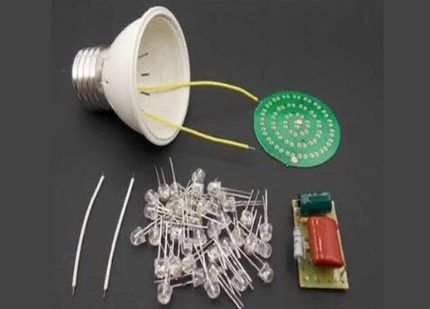
When thinking through the device, you should also solve a number of design problems, namely:
- how to arrange the circuit and LEDs;
- how to isolate the system;
- how to ensure heat exchange in the device.
Before assembly, it is advisable to think through all these problems, taking into account the requirements for a homemade light source.
LED lamp circuits
First of all, you should develop an assembly option. There are two main methods, each of which has its own pros and cons. Below we will look at them in more detail.
Option with diode bridge
The circuit includes four diodes that are connected in different directions.Thanks to this, the bridge acquires the ability to transform the mains current of 220 V into a pulsating one.
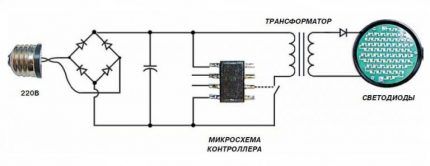
This happens as follows: when sinusoidal half-waves pass through two diodes, they change, which causes a loss of polarity.
During assembly, a capacitor is connected to the positive output in front of the bridge; in front of the negative terminal - a resistance of 100 Ohms. Another capacitor is installed behind the bridge: it will be needed to smooth out voltage drops.
Making an LED element
The easiest way to create an LED lamp is to make a light source based on a broken lamp. It is necessary to check the functionality of the detected parts, which can be done using a 12 V battery.
Defective elements must be replaced. To do this, you should unsolder the contacts, remove the burnt out elements, and put new ones in their place. In this case, it is important to observe the alternation of anodes and cathodes, which are attached in series.
If you need to change only 2-3 pieces of the chip, you can simply solder them to the areas where the failed components were previously located.
For complete self-assembly, you need to connect 10 diodes in a row, observing the polarity rules. Several completed circuits are soldered to the wires.
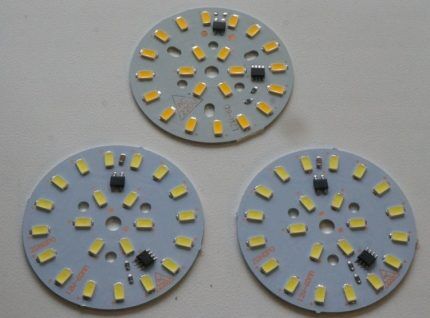
When assembling circuits, it is important to ensure that the soldered ends do not touch each other, as this can lead to a short circuit in the device and failure of the system.
Devices for softer light
To avoid the flickering characteristic of LED lamps, the circuit described above can be supplemented with several details. Thus, it should consist of a diode bridge, 100 and 230 Ohm resistors, 400 nF and 10 μF capacitors.
To protect the device from voltage surges, a 100 Ohm resistor is placed at the beginning of the circuit, followed by a 400 nF capacitor, after which a diode bridge and another 230 Ohm resistor are installed, followed by an assembled chain of LEDs.
Resistor devices
A similar scheme is also quite accessible to a novice master. To do this, you need two 12k resistors and two chains of the same number of LEDs, which are soldered in series, taking into account the polarity. In this case, one strip on the R1 side is connected to the cathode, and the other to R2, the anode.
Lamps made according to this scheme have a softer light, since the operating elements are lit in turn, making the pulsation of the flashes almost invisible to the naked eye.

The devices are successfully used as a table lamp and for other purposes. To create optimal lighting, experts recommend using strips of 20-40 diodes. A smaller number gives a small luminous flux; connecting a larger number of elements is technically quite difficult.
Important element: LED driver
For the correct operation of a DIY LED device, you need to resolve the issue with the driver. The layout of this unit is quite simple. The operating algorithm consists of passing an alternating current of 220V to the diode bridge through capacitor C1.
The rectified current goes to series-connected LEDs HL1-HL27, the number of which can reach 80 pieces.
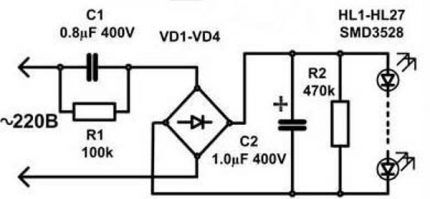
To avoid flicker and to achieve a consistently even color, it is advisable to use capacitor C2, which should have as large a capacity as possible.
Housings for LED devices
Before assembly, it is important to decide where the assembled circuit will be placed.
There are several options for solving this problem - to place the device you can use:
- lamp bases incandescent;
- housings from burnt-out energy-saving or halogen lamps;
- hand-made devices.
The first option has an important advantage. When using it, it is easy to screw the assembled LED device into the socket, thereby ensuring heat exchange.
It should be noted that in addition to the obvious advantages, this method also has obvious disadvantages. The assembled structure does not have a very aesthetic appearance; in addition, in this case it is difficult to provide reliable insulation.
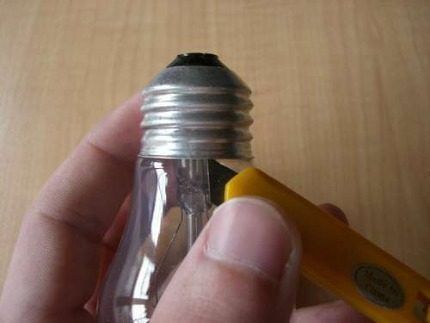
A convenient and practical option is to place a homemade device in the body of an energy-saving lamp. To do this, you first need to disassemble the burnt-out device by removing the converter board from it.
The assembled diagram can be inserted using different methods:
- The diodes are placed in holes made in the lid under the glass bulb.
- The circuit can be placed inside the base, which guarantees heat exchange. In this case, LED elements are inserted and fixed into existing holes.
- The board can be hidden in the base. To carry out the process, it is convenient to use a regular plastic cap from a water bottle.
To place LEDs, craftsmen often use a hand-made circle of plastic or cardboard, in which holes are drilled for the diodes. When done carefully, such devices look quite aesthetically pleasing.
Another option is to use a halogen lamp housing. It is not widely used, since in this case it is not possible to screw the lamp into the socket. Nevertheless, a similar modification is used to make homemade indicators and other devices.
If you decide to use a light bulb body for your work, we recommend reading our other article, where we described in detail how to disassemble various types of light bulbs. More details - go to link.
Materials for making homemade products
In addition to the body, other elements will be required to create the lamp. These are, first of all, LEDs, which can be purchased in the form of LED strips or individual NK6 elements. The current strength of each part is 100-120 mA; voltage 3-3.3 V.
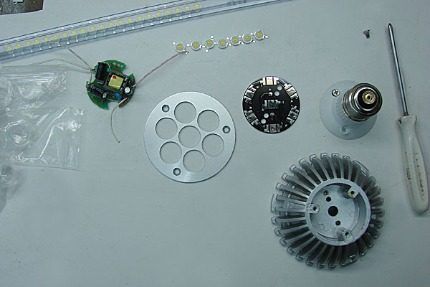
You also need 1N4007 rectifier diodes or a diode bridge, as well as fuses, which can be found in the base of an old device.
You will also need a capacitor, the capacitance and voltage of which must correspond to the electrical circuit used and the number of LED elements used in it.
If you are not using a ready-made board, you need to think about the frame to which the LEDs are attached. For its manufacture, a heat-resistant material that is not metal and non-conducting electric current is suitable.
As a rule, such a part is made of durable plastic or thick cardboard. To attach the LED elements to the frame you will need liquid nails or superglue.
Assembling a simple LED lamp
Let's consider the implementation of a lamp in a standard base from a fluorescent lamp. To do this, we will have to slightly change the above list of materials.
In this case we use:
- old base E27;
- NK6 LEDs;
- driver RLD2-1;
- a piece of plastic or thick cardboard;
- Super glue;
- electrical wiring;
- soldering iron, pliers, scissors.
Initially, you need to disassemble the lamp. For luminescent devices, the connection of the base to the plate with tubes is carried out using latches. It is important to locate the fastening location and pry the elements with a screwdriver, which will allow you to easily disconnect the cartridge.
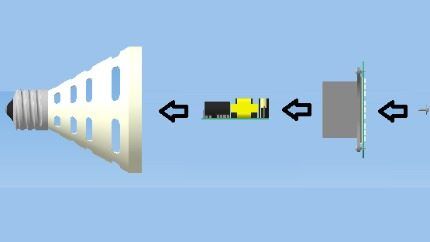
When disassembling the device, extreme care must be taken so as not to damage the tubes that contain a toxic substance inside. At the same time, it is necessary to monitor the integrity of the electrical wiring connected to the base, as well as preserve the parts contained in it.
We use the upper part with connected gas-discharge tubes to make the plate necessary for connecting the LEDs. It is enough to remove the tubular elements and attach the LED parts to the remaining round holes.
To secure them securely, it is better to make an additional plastic or cardboard cover, which will serve to isolate the chips.
The lamp will use NK6 LEDs, each of which consists of 6 crystals with parallel connection. They allow you to create a fairly bright lighting device with a minimum of electricity consumption.
To connect each LED to the cover, you need to make two holes. They should be pierced carefully in strict accordance with the diagram.
The plastic part allows you to firmly fix the LED elements, while the use of cardboard requires additional fastening of the LEDs to the base using liquid nails or superglue.
Since the device is designed to use six LEDs with a power of 0.5 watts each, the circuit must include three elements connected in parallel.
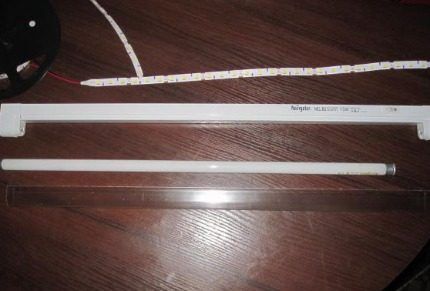
In a design that will operate from a 220 V power supply, you need to provide an RLD2-1 driver, which you should purchase in a store or do it yourself.
To avoid short circuits, it is important to insulate the driver and board from each other using plastic or cardboard before starting assembly. Since the lamp barely heats up, there is no need to worry about overheating.
Having selected all the components, you can assemble the structure according to the diagram, and then connect it to the electrical network to check the glow.
The device, operating from a standard 220 V power supply, has low energy consumption and a power of 3 Watts. The latter figure is 2-3 times less than that of fluorescent devices and 10 times less than that of incandescent lamps.
Although the light output is only 100-120 lumens, the dazzling white color makes the lamp appear much brighter. The assembled lamp can be used as a table lamp or to illuminate a compact room, for example, a corridor or closet.
Conclusions and useful video on the topic
In the video below you can see a detailed description of a specialist about self-assembly of an LED lamp:
LED lamps, made independently, have high technical characteristics. They are almost as good as factory models in terms of qualities such as strength, reliability, and durability.
The assembly of such devices is accessible to almost everyone: to successfully complete it, you just need to strictly follow the diagrams and carefully carry out all the prescribed manipulations.
Perhaps you have already assembled an LED lamp with your own hands and can you give valuable advice to visitors to our site? Or did you have any questions after reading the article? Please leave your comments in the block below.




Interesting read, but I doubt anyone would make a homemade LED light bulb. Unless, purely out of curiosity and academic interest, you can try to make one, using different schemes. In general, LED lamps have many advantages - they last a long time, require little electricity, produce little heat, and offer a wide selection of colors.
Exactly. I read the material with interest, but I don’t see any practical use for homemade LED dumps.
A sound idea for those who like to hold a soldering iron in their hands and also have a little time and desire. Considering the widespread use of LED light bulbs, the material costs for their assembly tend to zero; it is enough not to throw away lamps that have stopped working (including those from friends). In some, the LEDs themselves “burn”, in others, the capacitor or diode bridge fails, the cases almost always remain intact... Unless you can buy drivers if you want to put things on stream.